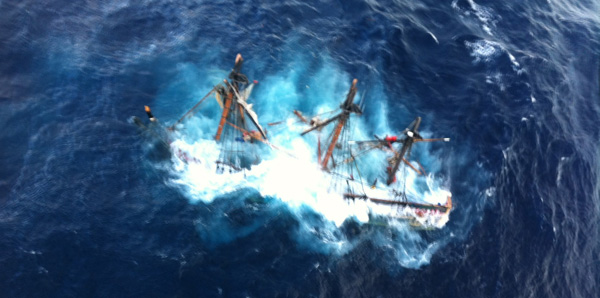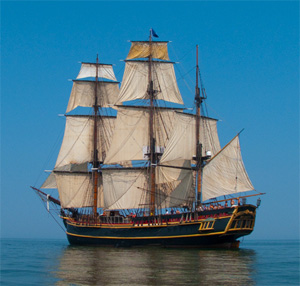The sinking of the tall ship HMS Bounty in October 2012 was the result of its captain’s “reckless decision to sail into the well-forecasted path of Hurricane Sandy” with an inexperienced and shorthanded crew on a vessel with a rotting hull, the National Transportation Safety Board (NTSB) said.
The captain, Robin Walbridge, and one crewmember died. Three others were seriously injured.
The 52-year-old replica of the 18th-century British vessel went to the bottom off Cape Hatteras, N.C. The $4 million ship was built for MGM Studios’ 1962 movie “Mutiny on the Bounty.”
“Although this wooden ship was modeled after an 18th-century vessel, the captain had access to 21st-century hurricane-modeling tools that predicted the path and severity of Hurricane Sandy,” NTSB Chairman Deborah A.P. Hersman said. “Bounty’s crew was put into an extraordinarily hazardous situation through decisions that by any measure didn’t prioritize safety.”
The findings of the 16-page NTSB report, issued in February, mirrored the testimony at Coast Guard hearings last year. The NTSB details the efforts of a mostly inexperienced and exhausted crew, including some injured from falls and others incapacitated by seasickness, to keep balky engines and bilge pumps operating while the vessel was assaulted by 30-foot seas.
 |
|
Courtesy U.S. Coast Guard |
|
During Hurricane Sandy, the wooden ship capsized and eventually sank off Cape Hatteras. Two people were killed and three were seriously injured. |
“The National Transportation Safety Board determines that the probable cause of the sinking of tall ship Bounty was the captain’s reckless decision to sail the vessel into the well-forecasted path of Hurricane Sandy, which subjected the aging vessel and the inexperienced crew to conditions from which the vessel could not recover,” the report stated. “Contributing to the sinking was the lack of effective safety oversight by the vessel organization.”
Bounty left New London, Conn., on the evening of Oct. 25, 2012, a day after closely watched Sandy had reached hurricane strength. The 180-foot-long tall ship was bound for St. Petersburg, Fla., on a course that took it into the forecasted path of the hurricane.
Before casting off, the report said, some crewmembers voiced concerns to the captain that sailing with Sandy approaching could put them and the ship at risk. The captain assured them that Bounty had weathered storms before and could handle what Sandy would present. A month earlier, in an interview with a Maine TV station, the captain said that Bounty “chased hurricanes” and by getting near a storm the sailors could take advantage of the high winds.
“Most of the crewmembers were inexperienced and their complement was smaller than usual,” the report said. “In addition, despite the fact that the Bounty took on water even in good conditions — and that wood rot had been discovered during the shipyard period — the captain gave no order to ensure that all onboard pumps were fully operational before departing, even though he knew that the vessel was sure to encounter rough seas during the voyage.”
“The chief mate testified that he twice recommended to the captain that they abandon ship while the vessel was still upright,” the report said.
Early on Oct. 29, 2012, about 110 miles southeast of Cape Hatteras, Bounty heeled sharply to starboard after taking on more than 10 feet of water in its hold after a three-and-a-half-day voyage that the NTSB said “should never have been attempted.”
Despite winds gusting almost 100 mph, the U.S. Coast Guard was able to rescue all but two of the 16 aboard by hoisting them from the sea into three Jayhawk helicopters. The body of one crewmember was recovered in an immersion suit about 10 hours after rescue operations had commenced. The captain was never found.
Before the voyage, Bounty had been laid up in a Maine shipyard for maintenance and repairs. The safety board said that most of the work was done by the crew, which had little experience in that kind of specialized work. They caulked seams in the wooden hull, which had known areas of rot, with compounds supplied by the captain, including a silicone sealant marketed for household use, the report said.
The organization that owned and operated the ship, HMS Bounty Organization LLC, did nothing to dissuade the captain from sailing into known severe weather conditions, compounding Walbridge’s error, the NTSB said.
Bounty’s owner, Long Island businessman Robert Hansen, did not respond to a request for comment.
The vessel was built larger than its namesake to accommodate filming equipment and personnel. After the Marlon Brando movie was completed, Bounty traveled the world on a promotional tour for the movie. In 1965, the vessel arrived in St. Petersburg, Fla., where it spent most of the next 21 years primarily as a dockside tourist attraction. In 1986, Turner Broadcasting bought Bounty and in 1993 donated the vessel to the city of Fall River, Mass., where it sat deteriorating until Hansen bought it in 2001.
Hansen struggled to provide adequate maintenance and only kept the ship afloat with large infusions of cash provided by Disney when it was used in filming two of the “Pirates of the Caribbean” movies. He put the ship up for sale in 2010 and was still negotiating a potential sale when it sank.
The NTSB said among the major repair projects, oak planking below the waterline had been replaced in 2002, and during 2007 the planking above the waterline was replaced.
During September 2012, Bounty was repaired at a shipyard in Boothbay Harbor, Maine. Walbridge, who had run Bounty for 17 years, supervised all of the work. It included moving the crew quarters forward, installing new fuel tanks, repositioning water tanks, installing a companionway from the tween deck up and onto the weather deck, constructing new spars for the masts, repositioning ballast from forward to aft and repairing the hull.
The Coast Guard certificated Bounty as a “moored attraction vessel” which allowed visitors aboard when the vessel was docked. But it could not carry passengers when underway.
When Bounty transited between event sites with just the crew on board, the vessel was considered simply a recreational/private vessel, subject to very few requirements of the Coast Guard’s regulations, the NTSB said.
As recently as 2012, the vessel organization had sought approval for Bounty to carry passengers underway. The American Bureau of Shipping considered the request and identified several modifications that would be required. These included addressing openings in watertight bulkheads. “However, because of financial constraints, the vessel organization did not pursue the matter and the modifications were never made,” the report said.

